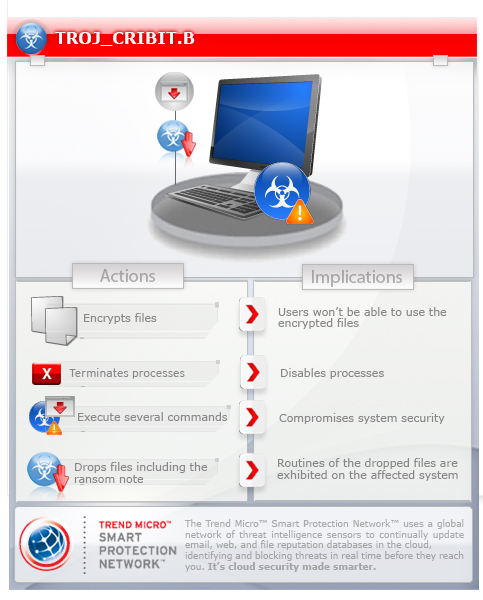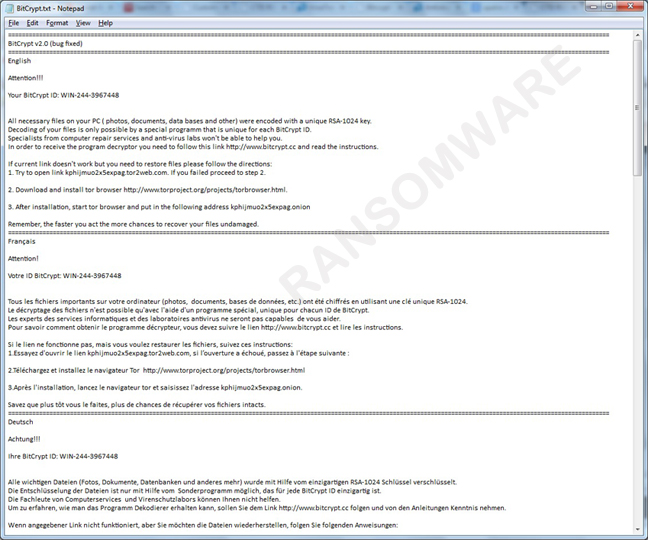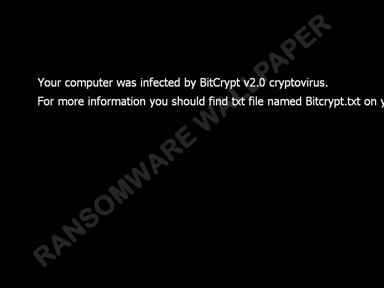TROJ_CRIBIT.B
Backdoor.Win32.Androm.dowv (Kaspersky), Trojan.Fakeavlock (Symantec), Mal/VBInj-AO (Sophos), Win32/Filecoder.CE trojan (ESET)
Windows 2000, Windows Server 2003, Windows XP (32-bit, 64-bit), Windows Vista (32-bit, 64-bit), Windows 7 (32-bit, 64-bit)


Threat Type: Trojan
Destructiveness: No
Encrypted: Yes
In the wild: Yes
OVERVIEW
Downloaded from the Internet, Dropped by other malware
This threat, dubbed as BitCrypt, is a ransomware that steals funds from various cryptocurrency wallets.
To get a one-glance comprehensive view of the behavior of this Trojan, refer to the Threat Diagram shown below.

This Trojan arrives on a system as a file dropped by other malware or as a file downloaded unknowingly by users when visiting malicious sites. It may be downloaded by other malware/grayware from remote sites.
It deletes the initially executed copy of itself.
TECHNICAL DETAILS
312,032 bytes
EXE
Yes
09 Mar 2014
Compromises system security, Terminates processes, Encrypts files
Arrival Details
This Trojan arrives on a system as a file dropped by other malware or as a file downloaded unknowingly by users when visiting malicious sites.
It may be downloaded by the following malware/grayware from remote sites:
- TSPY_FAREIT.BB
It may be downloaded from the following remote site(s):
- http://{BLOCKED}directory.com/file/win.exe
Installation
This Trojan drops the following component file(s):
- %Application Data%\BitCrypt.txt - contains ransom message
- %Application Data%\BitCrypt.bmp - used as wallpaper
- %Application Data%\bitcrypt.ccw - configuration file
(Note: %Application Data% is the current user's Application Data folder, which is usually C:\Documents and Settings\{user name}\Application Data on Windows 2000, XP, and Server 2003, or C:\Users\{user name}\AppData\Roaming on Windows Vista and 7.)
It drops the following copies of itself into the affected system:
- %Application Data%\{random filename}.exe - deleted after encryption routine
(Note: %Application Data% is the current user's Application Data folder, which is usually C:\Documents and Settings\{user name}\Application Data on Windows 2000, XP, and Server 2003, or C:\Users\{user name}\AppData\Roaming on Windows Vista and 7.)
It leaves text files that serve as ransom notes containing the following:
Autostart Technique
This Trojan adds the following registry entries to enable its automatic execution at every system startup:
HKEY_CURRENT_USER\Software\Microsoft\
Windows\CurrentVersion\Run
Bitcomint = "%Application Data%\{random filename}.exe" (This is deleted after the malware successfully encrypted user's files)
Other System Modifications
This Trojan deletes the following registry keys:
HKEY_LOCAL_MACHINE\SYSTEM\CurrentControlSet\
Control\SafeBoot\Minimal
HKEY_LOCAL_MACHINE\SYSTEM\CurrentControlSet\
Control\SafeBoot\Network
It sets the system's desktop wallpaper to the following image:
Process Termination
This Trojan terminates the following processes if found running in the affected system's memory:
- taskmgr.exe
- regedit.exe
Other Details
This Trojan encrypts files with the following extensions:
- *.dbf
- *.mdb
- *.mde
- *.xls
- *.xlw
- *.docx
- *.doc
- *.cer
- *.key
- *.rtf
- *.xlsm
- *.xlsx
- *.txt
- *.xlc
- *.docm
- *.xlk
- *.text
- *.ppt
- *.djvu
- *.lzo
- *.djv
- *.cdx
- *.cdt
- *.cdr
- *.bpg
- *.xfm
- *.dfm
- *.pas
- *.dpk
- *.dpr
- *.frm
- *.vbp
- *.php
- *.js
- *.wri
- *.css
- *.asm
- *.jpg
- *.jpeg
- *.dbx
- *.dbt
- *.odc
- *.sql
- *.abw
- *.pab
- *.vsd
- *.xsf
- *.xsn
- *.pps
- *.lzh
- *.pgp
- *.arj
- *.gz
- *.pst
- *.xl
It deletes the initially executed copy of itself
NOTES:
This Trojan deletes itself, the copy that it drops and the added autorun registry after successfully encrypting user's files in all fixed drives.
It queries the value of the following key which contains the Microsoft Geographical Location Value:
HKEY_CURRENT_USER\Control Panel\International\Geo\Nation
The value is used as a part of the Bitcrypt ID.
It also executes the following commands:
- cmd.exe /K bcdedit /set {bootmgr} displaybootmenu no
- cmd.exe /K bcdedit /set {default} bootstatuspolicy ignoreallfailures
It appends the string bitcrypt2 to the encrypted file's extension.
SOLUTION
9.700
10.657.00
10 Mar 2014
Step 1
Before doing any scans, Windows XP, Windows Vista, and Windows 7 users must disable System Restore to allow full scanning of their computers.
Step 3
Search and delete these files
- %Application Data%\BitCrypt.txt
- %Application Data%\BitCrypt.bmp
- %Application Data%\bitcrypt.ccw
Step 4
Restoring Deleted Registry Keys
- Still in Registry Editor, in the left panel, double-click the following:
HKEY_LOCAL_MACHINE>SYSTEM>CurrentControlSet>
Control>SafeBoot>Minimal - Right-click on the key and choose New>Key. Change the value of the new key to:
{4D36E967-E325-11CE-BFC1-08002BE10318} - Right-click on the value name and choose Modify. Change the value data of this entry to:
DiskDrive - In the left panel, double-click the following:
HKEY_LOCAL_MACHINE>SYSTEM>CurrentControlSet>
Control>SafeBoot>Network - Right-click on the key and choose New>Key. Change the value of the new key to:
{4D36E967-E325-11CE-BFC1-08002BE10318} - Right-click on the value name and choose Modify. Change the value data of this entry to:
DiskDrive - Close Registry Editor.
Step 5
Scan your computer with your Trend Micro product to delete files detected as TROJ_CRIBIT.B. If the detected files have already been cleaned, deleted, or quarantined by your Trend Micro product, no further step is required. You may opt to simply delete the quarantined files. Please check this Knowledge Base page for more information.
Did this description help? Tell us how we did.



